A Comprehensive Report on Talent Development Program and Mentoring
VerifiedAdded on 2020/02/24
|13
|2203
|188
Report
AI Summary
This report delves into the critical role of coaching and mentoring within talent development programs, offering a comprehensive analysis of various models and their applications. It examines both generic and specific coaching and mentoring models, including the GROW, OSCAR, and STEER models, evaluating their potential for enhancing talent development initiatives. The report highlights the essential competencies required by line managers, coaches, and employees for effective coaching, emphasizing the importance of empathy, listening skills, and problem-solving abilities. Furthermore, it outlines methods for establishing the need for support within organizations, such as the Purpose, Perspective, and Process Model, and the Nested-level models. The report also details the design and implementation of a talent development program, covering aspects like identifying company needs, analyzing succession plans, and fostering open communication. Finally, the report stresses the significance of continuous evaluation and feedback in ensuring the success of these programs, concluding that a balanced approach to coaching and mentoring is crucial for organizational growth.
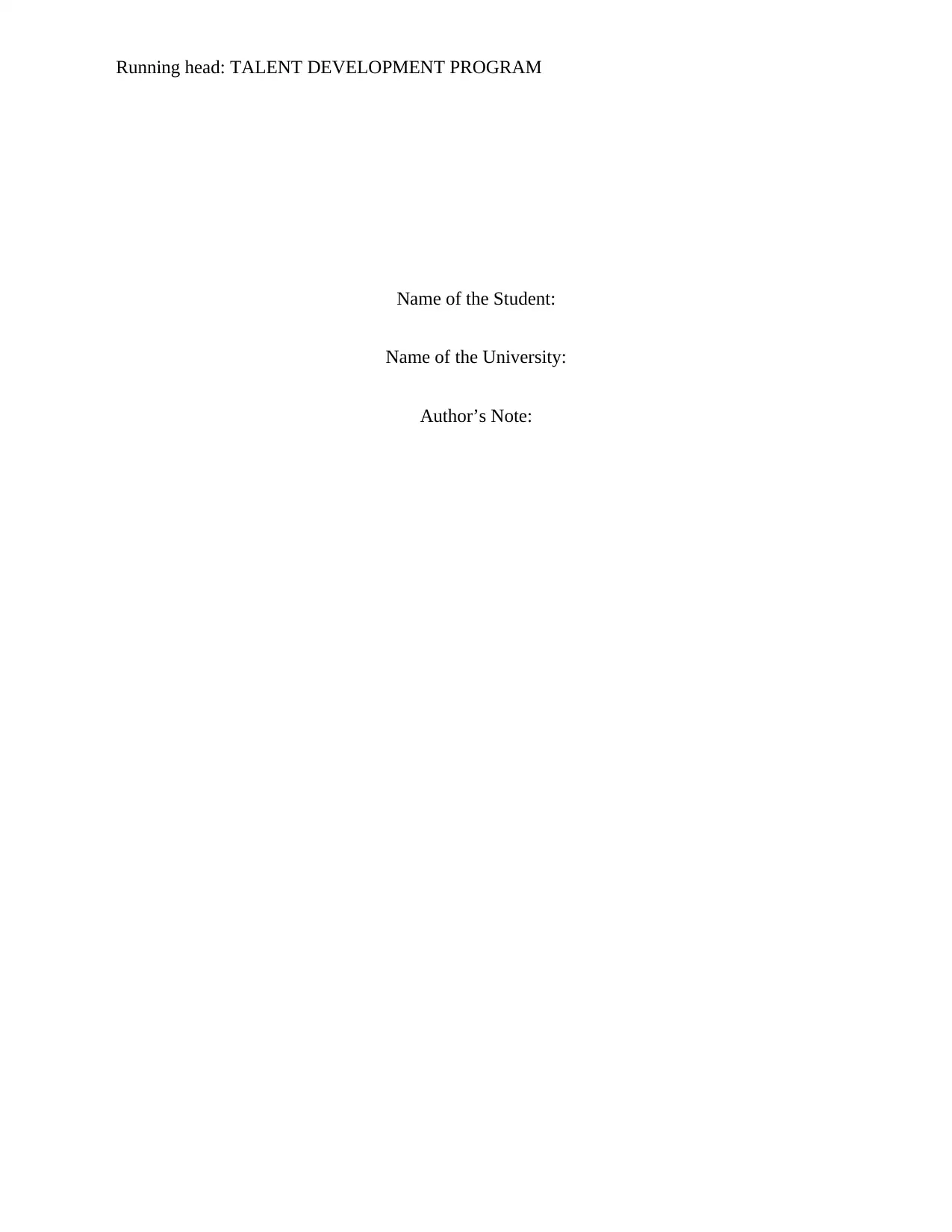
Running head: TALENT DEVELOPMENT PROGRAM
Name of the Student:
Name of the University:
Author’s Note:
Name of the Student:
Name of the University:
Author’s Note:
Paraphrase This Document
Need a fresh take? Get an instant paraphrase of this document with our AI Paraphraser
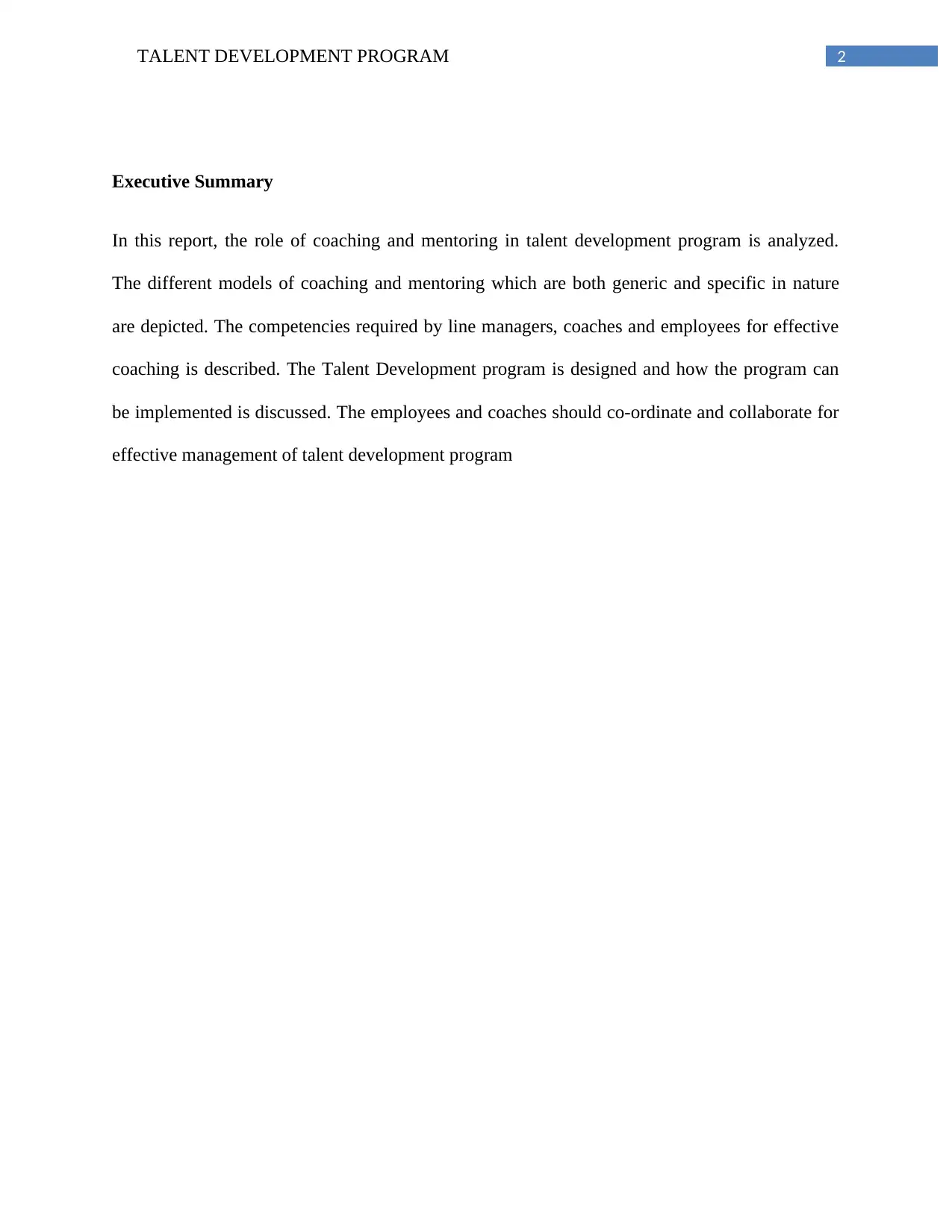
2TALENT DEVELOPMENT PROGRAM
Executive Summary
In this report, the role of coaching and mentoring in talent development program is analyzed.
The different models of coaching and mentoring which are both generic and specific in nature
are depicted. The competencies required by line managers, coaches and employees for effective
coaching is described. The Talent Development program is designed and how the program can
be implemented is discussed. The employees and coaches should co-ordinate and collaborate for
effective management of talent development program
Executive Summary
In this report, the role of coaching and mentoring in talent development program is analyzed.
The different models of coaching and mentoring which are both generic and specific in nature
are depicted. The competencies required by line managers, coaches and employees for effective
coaching is described. The Talent Development program is designed and how the program can
be implemented is discussed. The employees and coaches should co-ordinate and collaborate for
effective management of talent development program
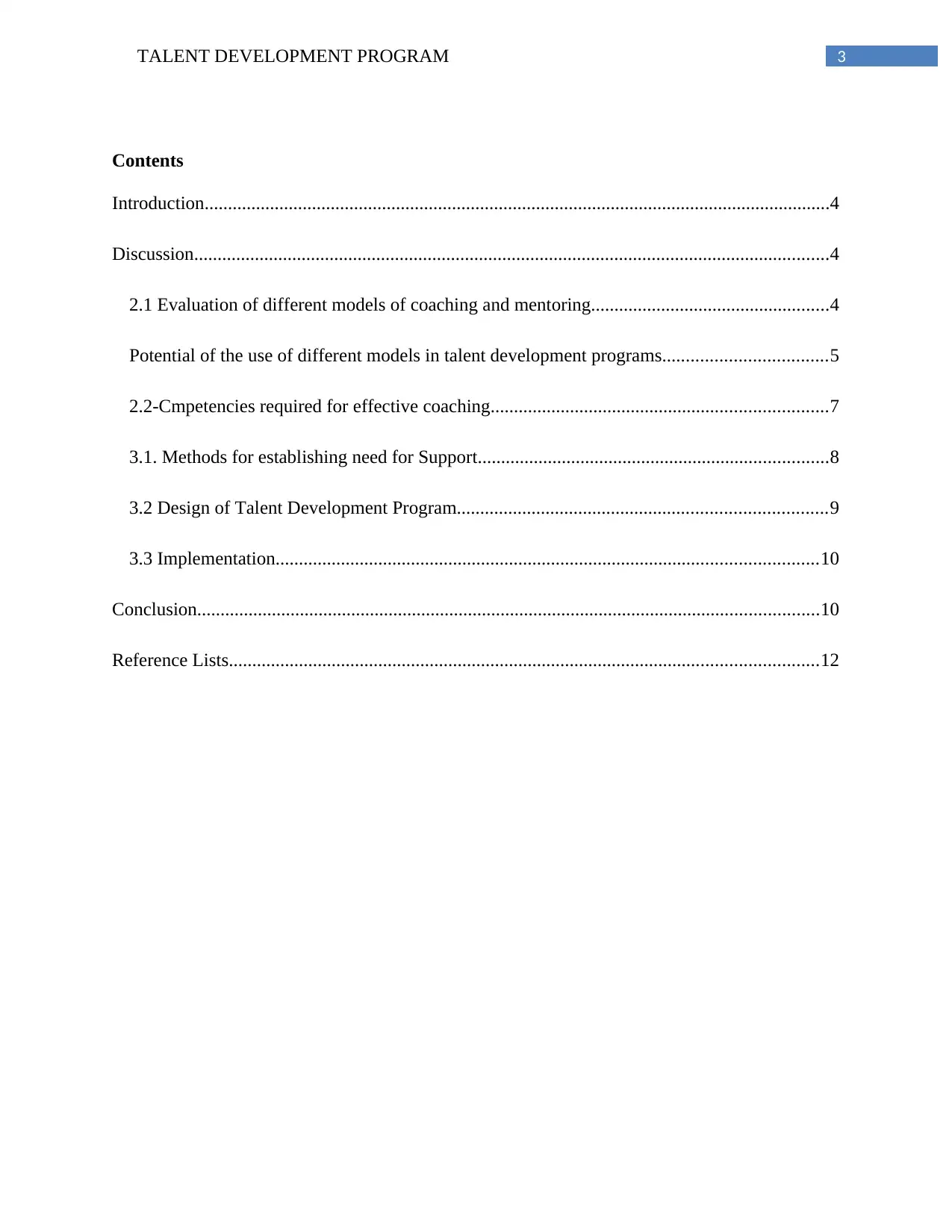
3TALENT DEVELOPMENT PROGRAM
Contents
Introduction......................................................................................................................................4
Discussion........................................................................................................................................4
2.1 Evaluation of different models of coaching and mentoring...................................................4
Potential of the use of different models in talent development programs...................................5
2.2-Cmpetencies required for effective coaching........................................................................7
3.1. Methods for establishing need for Support...........................................................................8
3.2 Design of Talent Development Program...............................................................................9
3.3 Implementation....................................................................................................................10
Conclusion.....................................................................................................................................10
Reference Lists..............................................................................................................................12
Contents
Introduction......................................................................................................................................4
Discussion........................................................................................................................................4
2.1 Evaluation of different models of coaching and mentoring...................................................4
Potential of the use of different models in talent development programs...................................5
2.2-Cmpetencies required for effective coaching........................................................................7
3.1. Methods for establishing need for Support...........................................................................8
3.2 Design of Talent Development Program...............................................................................9
3.3 Implementation....................................................................................................................10
Conclusion.....................................................................................................................................10
Reference Lists..............................................................................................................................12
⊘ This is a preview!⊘
Do you want full access?
Subscribe today to unlock all pages.

Trusted by 1+ million students worldwide
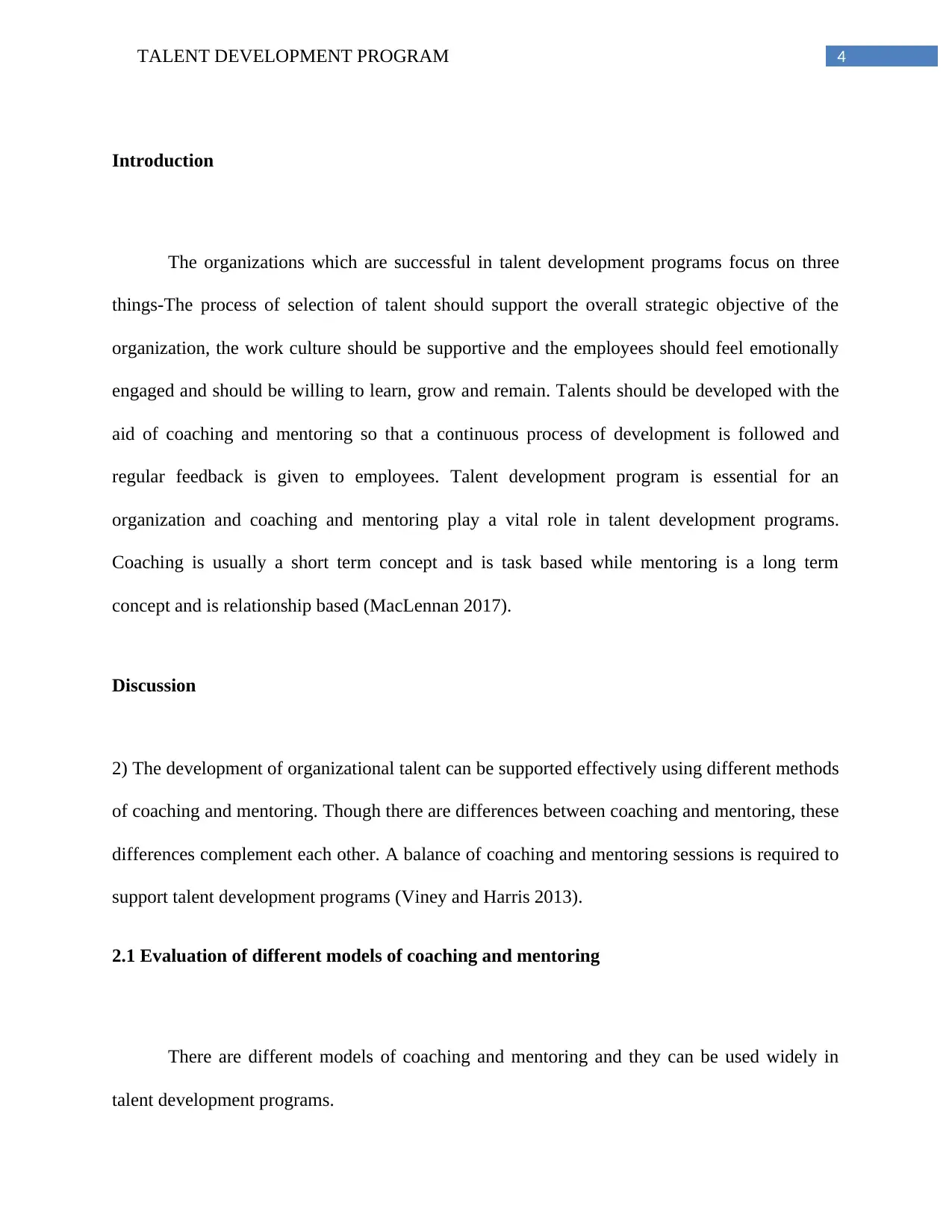
4TALENT DEVELOPMENT PROGRAM
Introduction
The organizations which are successful in talent development programs focus on three
things-The process of selection of talent should support the overall strategic objective of the
organization, the work culture should be supportive and the employees should feel emotionally
engaged and should be willing to learn, grow and remain. Talents should be developed with the
aid of coaching and mentoring so that a continuous process of development is followed and
regular feedback is given to employees. Talent development program is essential for an
organization and coaching and mentoring play a vital role in talent development programs.
Coaching is usually a short term concept and is task based while mentoring is a long term
concept and is relationship based (MacLennan 2017).
Discussion
2) The development of organizational talent can be supported effectively using different methods
of coaching and mentoring. Though there are differences between coaching and mentoring, these
differences complement each other. A balance of coaching and mentoring sessions is required to
support talent development programs (Viney and Harris 2013).
2.1 Evaluation of different models of coaching and mentoring
There are different models of coaching and mentoring and they can be used widely in
talent development programs.
Introduction
The organizations which are successful in talent development programs focus on three
things-The process of selection of talent should support the overall strategic objective of the
organization, the work culture should be supportive and the employees should feel emotionally
engaged and should be willing to learn, grow and remain. Talents should be developed with the
aid of coaching and mentoring so that a continuous process of development is followed and
regular feedback is given to employees. Talent development program is essential for an
organization and coaching and mentoring play a vital role in talent development programs.
Coaching is usually a short term concept and is task based while mentoring is a long term
concept and is relationship based (MacLennan 2017).
Discussion
2) The development of organizational talent can be supported effectively using different methods
of coaching and mentoring. Though there are differences between coaching and mentoring, these
differences complement each other. A balance of coaching and mentoring sessions is required to
support talent development programs (Viney and Harris 2013).
2.1 Evaluation of different models of coaching and mentoring
There are different models of coaching and mentoring and they can be used widely in
talent development programs.
Paraphrase This Document
Need a fresh take? Get an instant paraphrase of this document with our AI Paraphraser
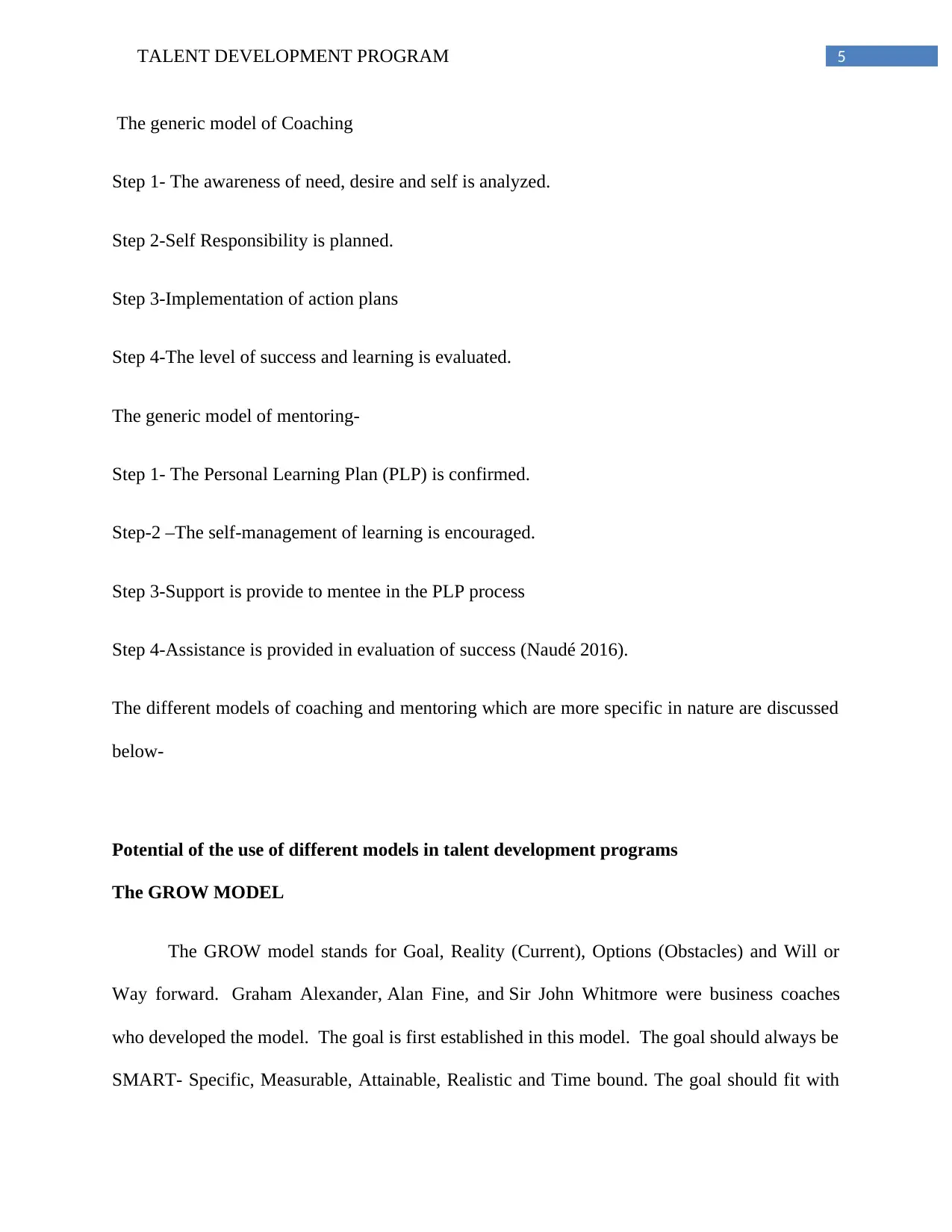
5TALENT DEVELOPMENT PROGRAM
The generic model of Coaching
Step 1- The awareness of need, desire and self is analyzed.
Step 2-Self Responsibility is planned.
Step 3-Implementation of action plans
Step 4-The level of success and learning is evaluated.
The generic model of mentoring-
Step 1- The Personal Learning Plan (PLP) is confirmed.
Step-2 –The self-management of learning is encouraged.
Step 3-Support is provide to mentee in the PLP process
Step 4-Assistance is provided in evaluation of success (Naudé 2016).
The different models of coaching and mentoring which are more specific in nature are discussed
below-
Potential of the use of different models in talent development programs
The GROW MODEL
The GROW model stands for Goal, Reality (Current), Options (Obstacles) and Will or
Way forward. Graham Alexander, Alan Fine, and Sir John Whitmore were business coaches
who developed the model. The goal is first established in this model. The goal should always be
SMART- Specific, Measurable, Attainable, Realistic and Time bound. The goal should fit with
The generic model of Coaching
Step 1- The awareness of need, desire and self is analyzed.
Step 2-Self Responsibility is planned.
Step 3-Implementation of action plans
Step 4-The level of success and learning is evaluated.
The generic model of mentoring-
Step 1- The Personal Learning Plan (PLP) is confirmed.
Step-2 –The self-management of learning is encouraged.
Step 3-Support is provide to mentee in the PLP process
Step 4-Assistance is provided in evaluation of success (Naudé 2016).
The different models of coaching and mentoring which are more specific in nature are discussed
below-
Potential of the use of different models in talent development programs
The GROW MODEL
The GROW model stands for Goal, Reality (Current), Options (Obstacles) and Will or
Way forward. Graham Alexander, Alan Fine, and Sir John Whitmore were business coaches
who developed the model. The goal is first established in this model. The goal should always be
SMART- Specific, Measurable, Attainable, Realistic and Time bound. The goal should fit with
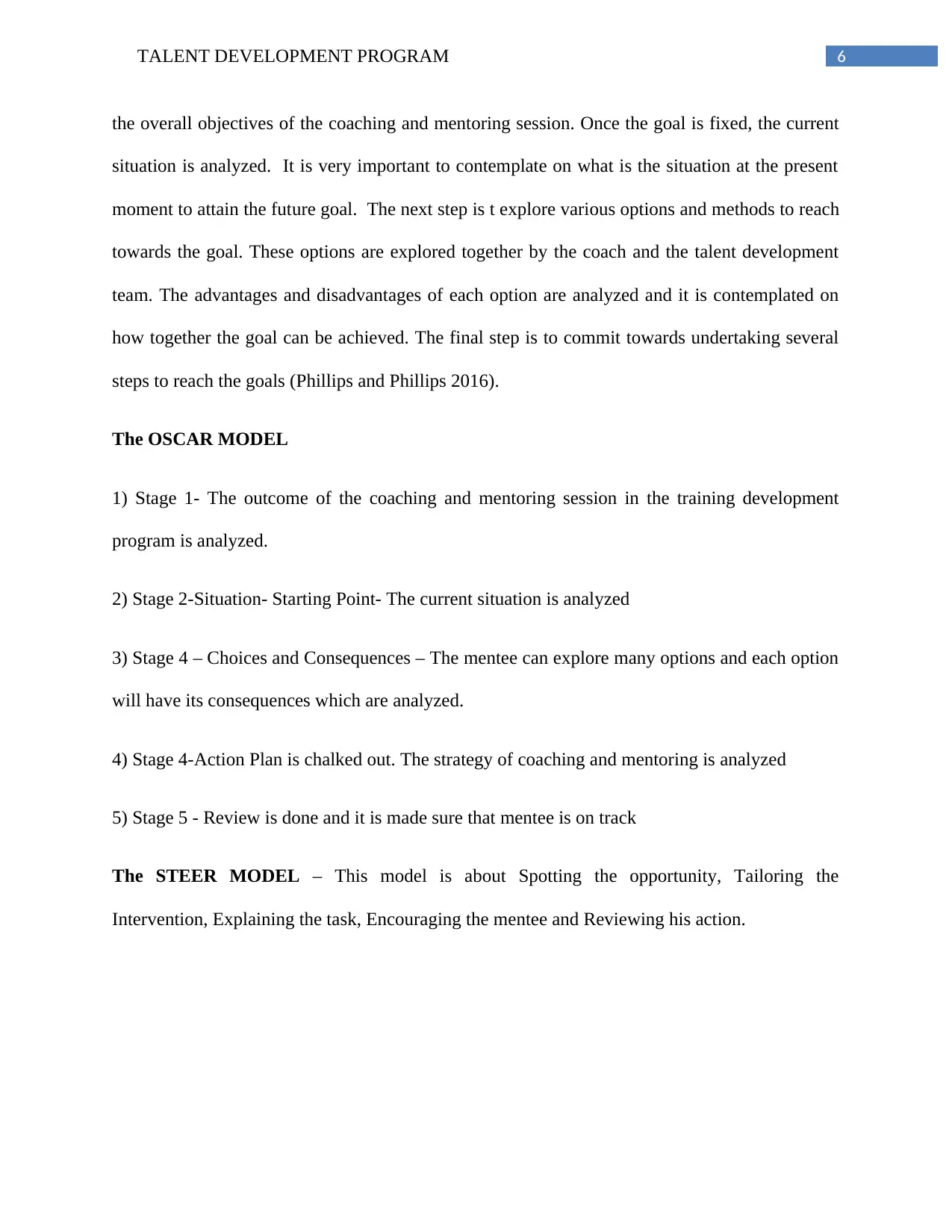
6TALENT DEVELOPMENT PROGRAM
the overall objectives of the coaching and mentoring session. Once the goal is fixed, the current
situation is analyzed. It is very important to contemplate on what is the situation at the present
moment to attain the future goal. The next step is t explore various options and methods to reach
towards the goal. These options are explored together by the coach and the talent development
team. The advantages and disadvantages of each option are analyzed and it is contemplated on
how together the goal can be achieved. The final step is to commit towards undertaking several
steps to reach the goals (Phillips and Phillips 2016).
The OSCAR MODEL
1) Stage 1- The outcome of the coaching and mentoring session in the training development
program is analyzed.
2) Stage 2-Situation- Starting Point- The current situation is analyzed
3) Stage 4 – Choices and Consequences – The mentee can explore many options and each option
will have its consequences which are analyzed.
4) Stage 4-Action Plan is chalked out. The strategy of coaching and mentoring is analyzed
5) Stage 5 - Review is done and it is made sure that mentee is on track
The STEER MODEL – This model is about Spotting the opportunity, Tailoring the
Intervention, Explaining the task, Encouraging the mentee and Reviewing his action.
the overall objectives of the coaching and mentoring session. Once the goal is fixed, the current
situation is analyzed. It is very important to contemplate on what is the situation at the present
moment to attain the future goal. The next step is t explore various options and methods to reach
towards the goal. These options are explored together by the coach and the talent development
team. The advantages and disadvantages of each option are analyzed and it is contemplated on
how together the goal can be achieved. The final step is to commit towards undertaking several
steps to reach the goals (Phillips and Phillips 2016).
The OSCAR MODEL
1) Stage 1- The outcome of the coaching and mentoring session in the training development
program is analyzed.
2) Stage 2-Situation- Starting Point- The current situation is analyzed
3) Stage 4 – Choices and Consequences – The mentee can explore many options and each option
will have its consequences which are analyzed.
4) Stage 4-Action Plan is chalked out. The strategy of coaching and mentoring is analyzed
5) Stage 5 - Review is done and it is made sure that mentee is on track
The STEER MODEL – This model is about Spotting the opportunity, Tailoring the
Intervention, Explaining the task, Encouraging the mentee and Reviewing his action.
⊘ This is a preview!⊘
Do you want full access?
Subscribe today to unlock all pages.

Trusted by 1+ million students worldwide
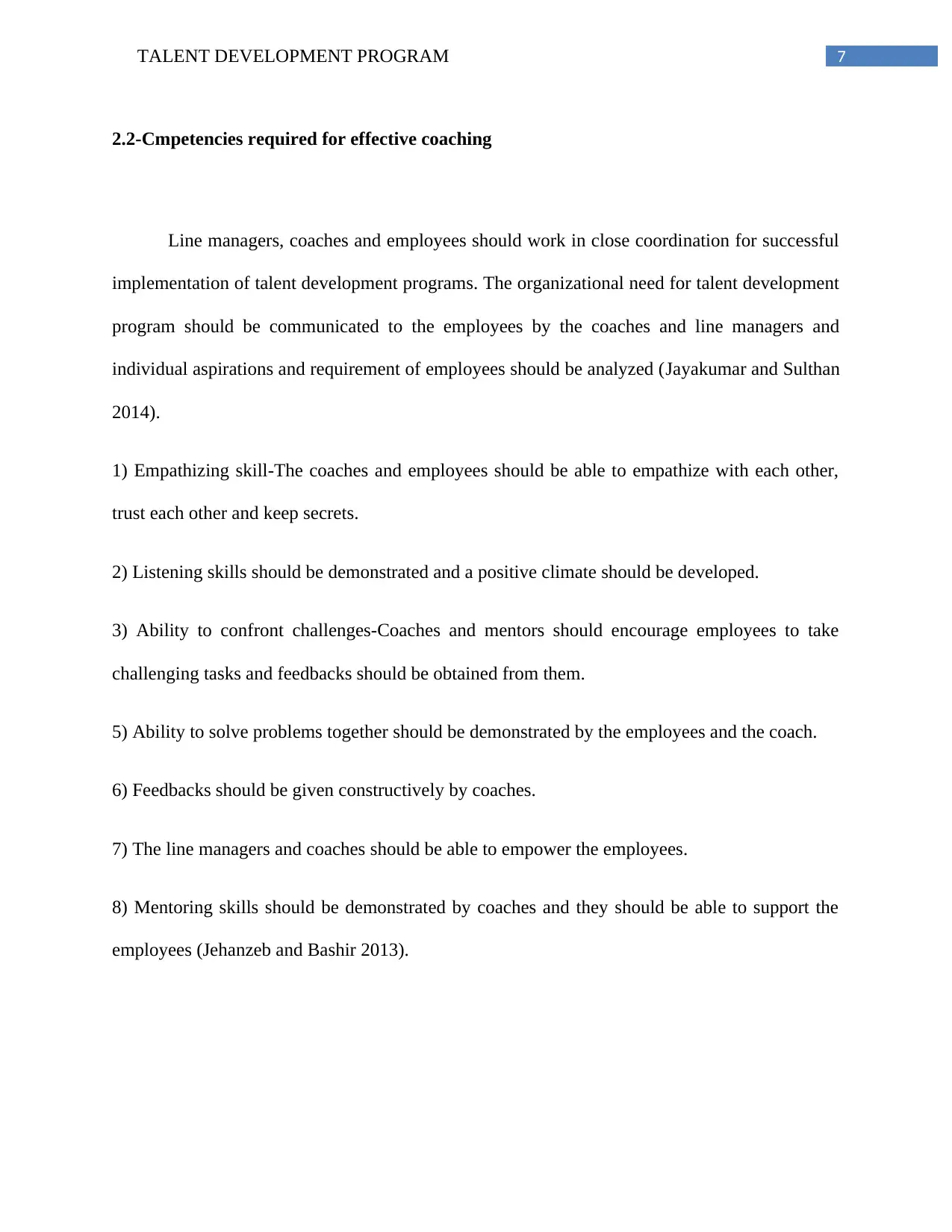
7TALENT DEVELOPMENT PROGRAM
2.2-Cmpetencies required for effective coaching
Line managers, coaches and employees should work in close coordination for successful
implementation of talent development programs. The organizational need for talent development
program should be communicated to the employees by the coaches and line managers and
individual aspirations and requirement of employees should be analyzed (Jayakumar and Sulthan
2014).
1) Empathizing skill-The coaches and employees should be able to empathize with each other,
trust each other and keep secrets.
2) Listening skills should be demonstrated and a positive climate should be developed.
3) Ability to confront challenges-Coaches and mentors should encourage employees to take
challenging tasks and feedbacks should be obtained from them.
5) Ability to solve problems together should be demonstrated by the employees and the coach.
6) Feedbacks should be given constructively by coaches.
7) The line managers and coaches should be able to empower the employees.
8) Mentoring skills should be demonstrated by coaches and they should be able to support the
employees (Jehanzeb and Bashir 2013).
2.2-Cmpetencies required for effective coaching
Line managers, coaches and employees should work in close coordination for successful
implementation of talent development programs. The organizational need for talent development
program should be communicated to the employees by the coaches and line managers and
individual aspirations and requirement of employees should be analyzed (Jayakumar and Sulthan
2014).
1) Empathizing skill-The coaches and employees should be able to empathize with each other,
trust each other and keep secrets.
2) Listening skills should be demonstrated and a positive climate should be developed.
3) Ability to confront challenges-Coaches and mentors should encourage employees to take
challenging tasks and feedbacks should be obtained from them.
5) Ability to solve problems together should be demonstrated by the employees and the coach.
6) Feedbacks should be given constructively by coaches.
7) The line managers and coaches should be able to empower the employees.
8) Mentoring skills should be demonstrated by coaches and they should be able to support the
employees (Jehanzeb and Bashir 2013).
Paraphrase This Document
Need a fresh take? Get an instant paraphrase of this document with our AI Paraphraser
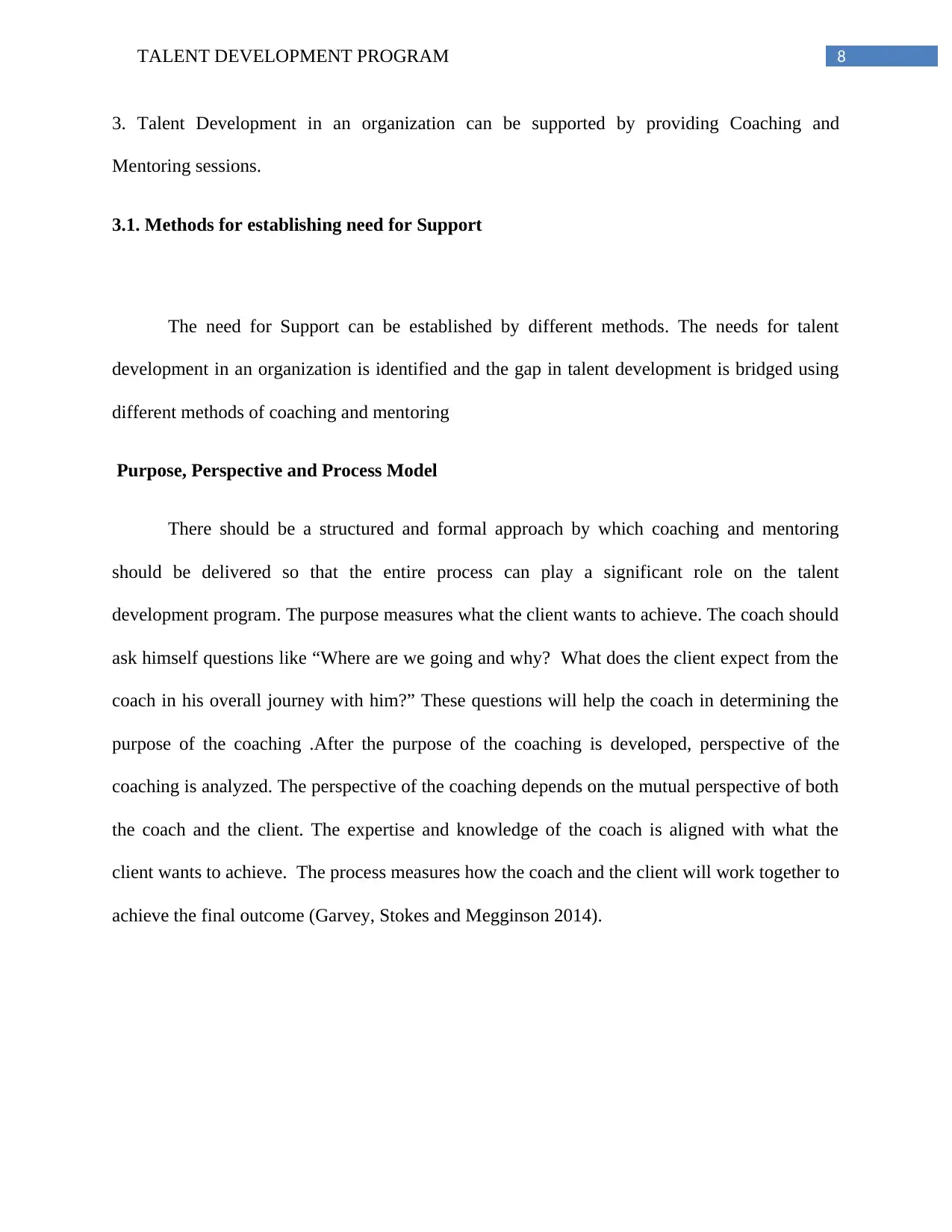
8TALENT DEVELOPMENT PROGRAM
3. Talent Development in an organization can be supported by providing Coaching and
Mentoring sessions.
3.1. Methods for establishing need for Support
The need for Support can be established by different methods. The needs for talent
development in an organization is identified and the gap in talent development is bridged using
different methods of coaching and mentoring
Purpose, Perspective and Process Model
There should be a structured and formal approach by which coaching and mentoring
should be delivered so that the entire process can play a significant role on the talent
development program. The purpose measures what the client wants to achieve. The coach should
ask himself questions like “Where are we going and why? What does the client expect from the
coach in his overall journey with him?” These questions will help the coach in determining the
purpose of the coaching .After the purpose of the coaching is developed, perspective of the
coaching is analyzed. The perspective of the coaching depends on the mutual perspective of both
the coach and the client. The expertise and knowledge of the coach is aligned with what the
client wants to achieve. The process measures how the coach and the client will work together to
achieve the final outcome (Garvey, Stokes and Megginson 2014).
3. Talent Development in an organization can be supported by providing Coaching and
Mentoring sessions.
3.1. Methods for establishing need for Support
The need for Support can be established by different methods. The needs for talent
development in an organization is identified and the gap in talent development is bridged using
different methods of coaching and mentoring
Purpose, Perspective and Process Model
There should be a structured and formal approach by which coaching and mentoring
should be delivered so that the entire process can play a significant role on the talent
development program. The purpose measures what the client wants to achieve. The coach should
ask himself questions like “Where are we going and why? What does the client expect from the
coach in his overall journey with him?” These questions will help the coach in determining the
purpose of the coaching .After the purpose of the coaching is developed, perspective of the
coaching is analyzed. The perspective of the coaching depends on the mutual perspective of both
the coach and the client. The expertise and knowledge of the coach is aligned with what the
client wants to achieve. The process measures how the coach and the client will work together to
achieve the final outcome (Garvey, Stokes and Megginson 2014).
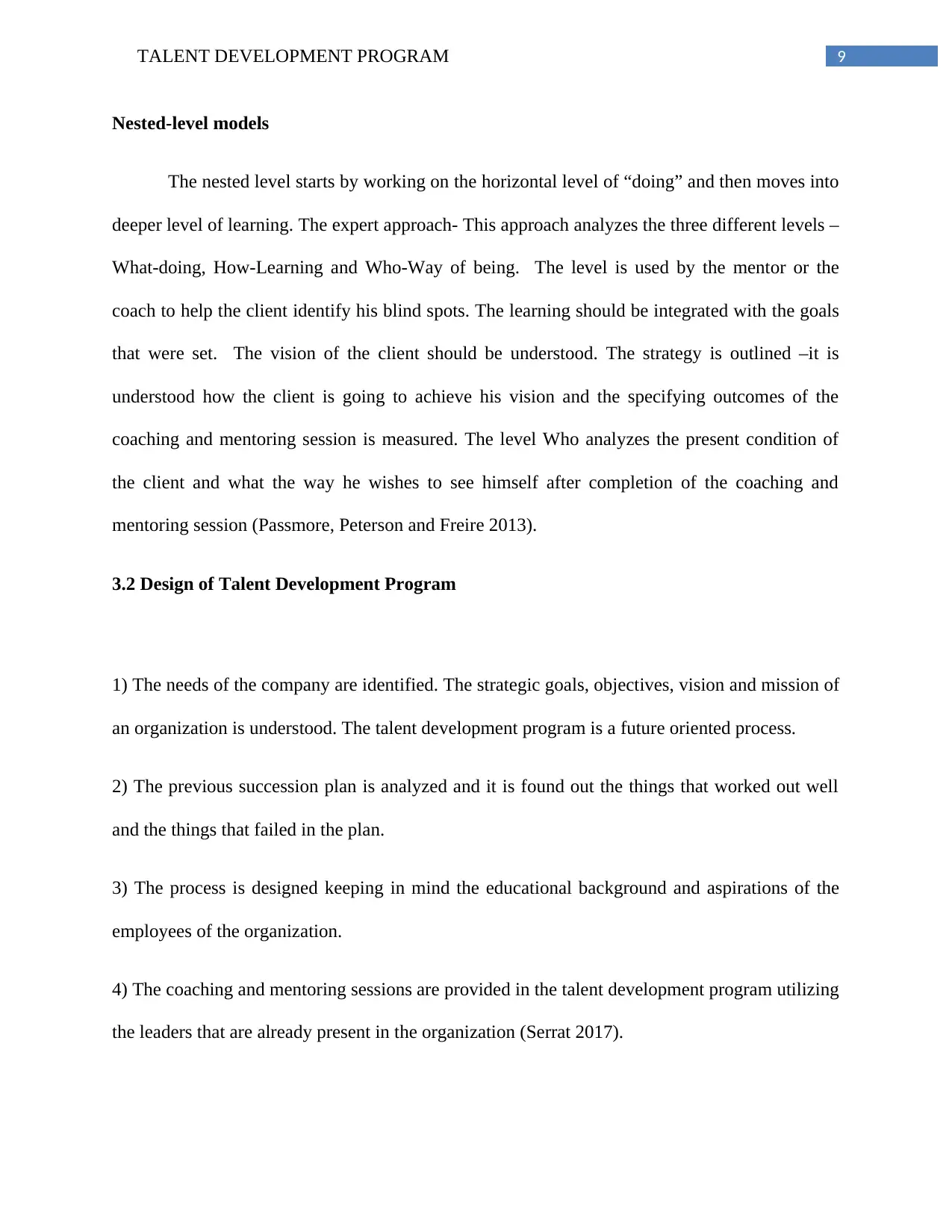
9TALENT DEVELOPMENT PROGRAM
Nested-level models
The nested level starts by working on the horizontal level of “doing” and then moves into
deeper level of learning. The expert approach- This approach analyzes the three different levels –
What-doing, How-Learning and Who-Way of being. The level is used by the mentor or the
coach to help the client identify his blind spots. The learning should be integrated with the goals
that were set. The vision of the client should be understood. The strategy is outlined –it is
understood how the client is going to achieve his vision and the specifying outcomes of the
coaching and mentoring session is measured. The level Who analyzes the present condition of
the client and what the way he wishes to see himself after completion of the coaching and
mentoring session (Passmore, Peterson and Freire 2013).
3.2 Design of Talent Development Program
1) The needs of the company are identified. The strategic goals, objectives, vision and mission of
an organization is understood. The talent development program is a future oriented process.
2) The previous succession plan is analyzed and it is found out the things that worked out well
and the things that failed in the plan.
3) The process is designed keeping in mind the educational background and aspirations of the
employees of the organization.
4) The coaching and mentoring sessions are provided in the talent development program utilizing
the leaders that are already present in the organization (Serrat 2017).
Nested-level models
The nested level starts by working on the horizontal level of “doing” and then moves into
deeper level of learning. The expert approach- This approach analyzes the three different levels –
What-doing, How-Learning and Who-Way of being. The level is used by the mentor or the
coach to help the client identify his blind spots. The learning should be integrated with the goals
that were set. The vision of the client should be understood. The strategy is outlined –it is
understood how the client is going to achieve his vision and the specifying outcomes of the
coaching and mentoring session is measured. The level Who analyzes the present condition of
the client and what the way he wishes to see himself after completion of the coaching and
mentoring session (Passmore, Peterson and Freire 2013).
3.2 Design of Talent Development Program
1) The needs of the company are identified. The strategic goals, objectives, vision and mission of
an organization is understood. The talent development program is a future oriented process.
2) The previous succession plan is analyzed and it is found out the things that worked out well
and the things that failed in the plan.
3) The process is designed keeping in mind the educational background and aspirations of the
employees of the organization.
4) The coaching and mentoring sessions are provided in the talent development program utilizing
the leaders that are already present in the organization (Serrat 2017).
⊘ This is a preview!⊘
Do you want full access?
Subscribe today to unlock all pages.

Trusted by 1+ million students worldwide
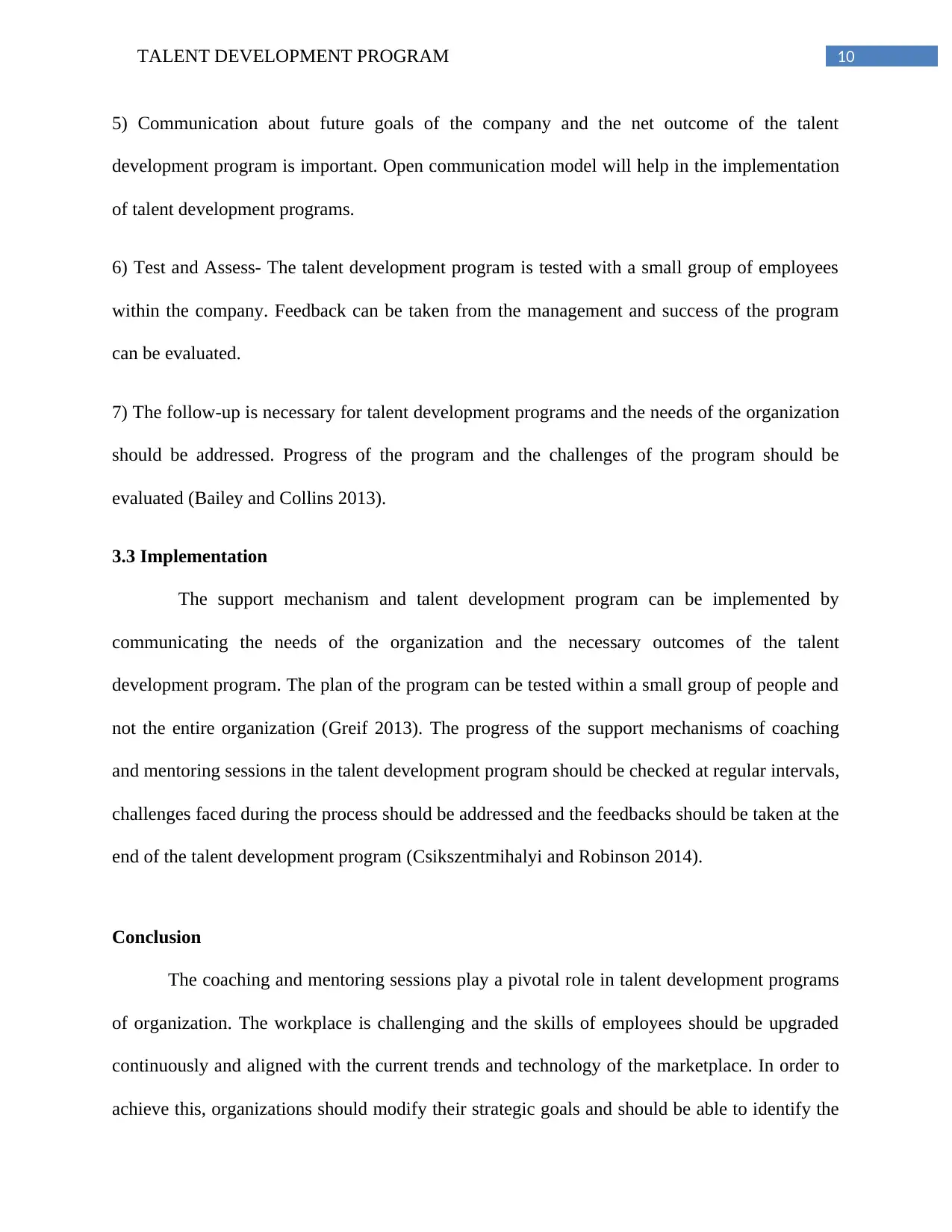
10TALENT DEVELOPMENT PROGRAM
5) Communication about future goals of the company and the net outcome of the talent
development program is important. Open communication model will help in the implementation
of talent development programs.
6) Test and Assess- The talent development program is tested with a small group of employees
within the company. Feedback can be taken from the management and success of the program
can be evaluated.
7) The follow-up is necessary for talent development programs and the needs of the organization
should be addressed. Progress of the program and the challenges of the program should be
evaluated (Bailey and Collins 2013).
3.3 Implementation
The support mechanism and talent development program can be implemented by
communicating the needs of the organization and the necessary outcomes of the talent
development program. The plan of the program can be tested within a small group of people and
not the entire organization (Greif 2013). The progress of the support mechanisms of coaching
and mentoring sessions in the talent development program should be checked at regular intervals,
challenges faced during the process should be addressed and the feedbacks should be taken at the
end of the talent development program (Csikszentmihalyi and Robinson 2014).
Conclusion
The coaching and mentoring sessions play a pivotal role in talent development programs
of organization. The workplace is challenging and the skills of employees should be upgraded
continuously and aligned with the current trends and technology of the marketplace. In order to
achieve this, organizations should modify their strategic goals and should be able to identify the
5) Communication about future goals of the company and the net outcome of the talent
development program is important. Open communication model will help in the implementation
of talent development programs.
6) Test and Assess- The talent development program is tested with a small group of employees
within the company. Feedback can be taken from the management and success of the program
can be evaluated.
7) The follow-up is necessary for talent development programs and the needs of the organization
should be addressed. Progress of the program and the challenges of the program should be
evaluated (Bailey and Collins 2013).
3.3 Implementation
The support mechanism and talent development program can be implemented by
communicating the needs of the organization and the necessary outcomes of the talent
development program. The plan of the program can be tested within a small group of people and
not the entire organization (Greif 2013). The progress of the support mechanisms of coaching
and mentoring sessions in the talent development program should be checked at regular intervals,
challenges faced during the process should be addressed and the feedbacks should be taken at the
end of the talent development program (Csikszentmihalyi and Robinson 2014).
Conclusion
The coaching and mentoring sessions play a pivotal role in talent development programs
of organization. The workplace is challenging and the skills of employees should be upgraded
continuously and aligned with the current trends and technology of the marketplace. In order to
achieve this, organizations should modify their strategic goals and should be able to identify the
Paraphrase This Document
Need a fresh take? Get an instant paraphrase of this document with our AI Paraphraser
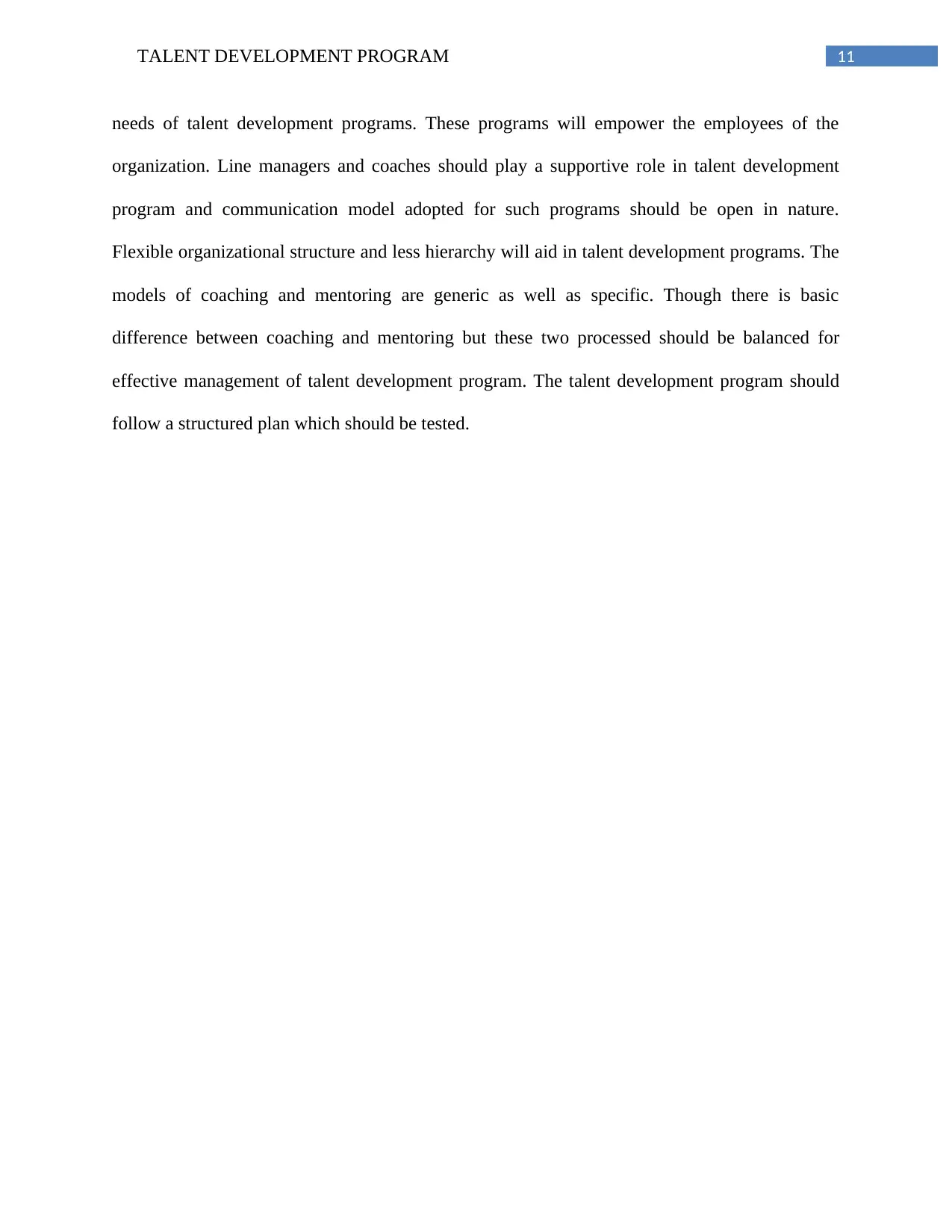
11TALENT DEVELOPMENT PROGRAM
needs of talent development programs. These programs will empower the employees of the
organization. Line managers and coaches should play a supportive role in talent development
program and communication model adopted for such programs should be open in nature.
Flexible organizational structure and less hierarchy will aid in talent development programs. The
models of coaching and mentoring are generic as well as specific. Though there is basic
difference between coaching and mentoring but these two processed should be balanced for
effective management of talent development program. The talent development program should
follow a structured plan which should be tested.
needs of talent development programs. These programs will empower the employees of the
organization. Line managers and coaches should play a supportive role in talent development
program and communication model adopted for such programs should be open in nature.
Flexible organizational structure and less hierarchy will aid in talent development programs. The
models of coaching and mentoring are generic as well as specific. Though there is basic
difference between coaching and mentoring but these two processed should be balanced for
effective management of talent development program. The talent development program should
follow a structured plan which should be tested.
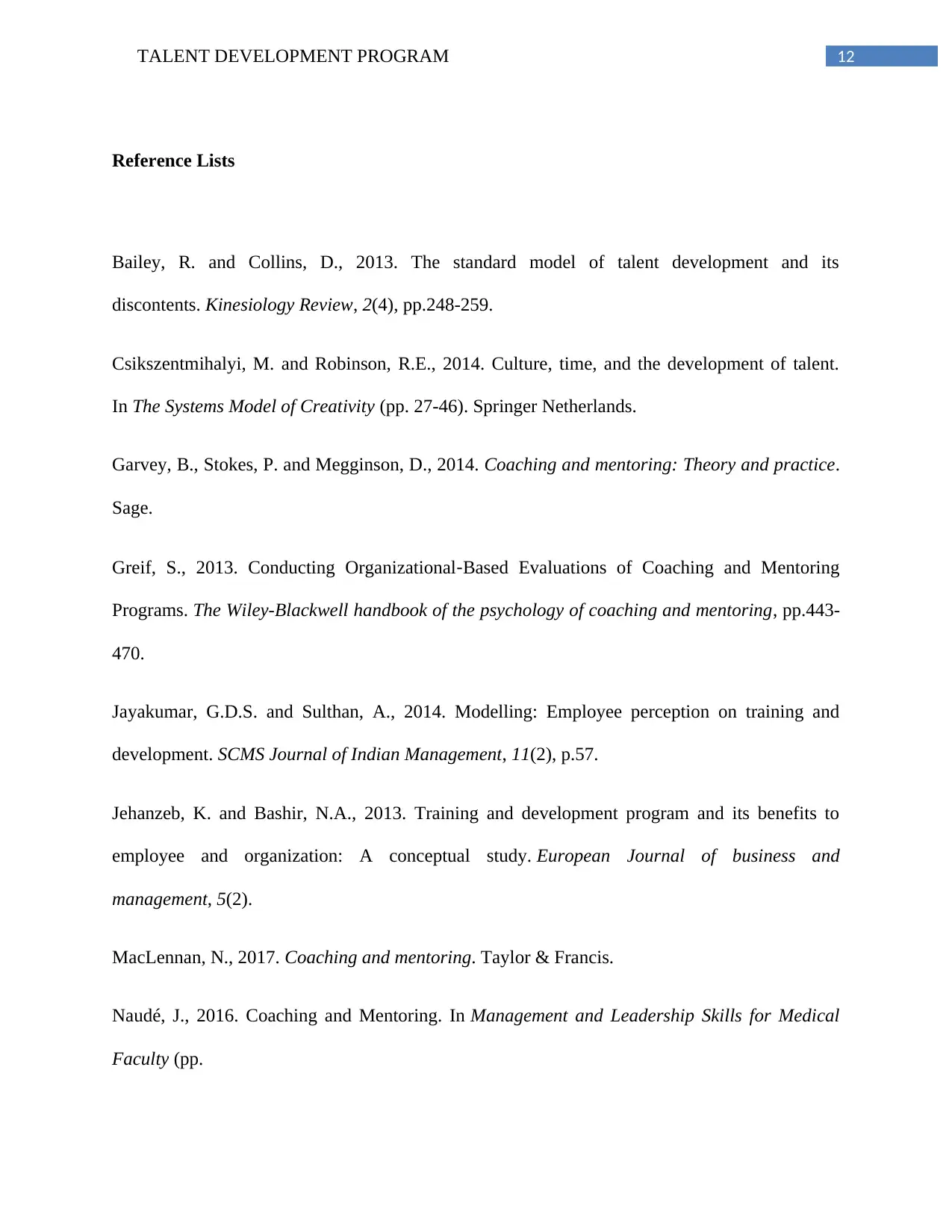
12TALENT DEVELOPMENT PROGRAM
Reference Lists
Bailey, R. and Collins, D., 2013. The standard model of talent development and its
discontents. Kinesiology Review, 2(4), pp.248-259.
Csikszentmihalyi, M. and Robinson, R.E., 2014. Culture, time, and the development of talent.
In The Systems Model of Creativity (pp. 27-46). Springer Netherlands.
Garvey, B., Stokes, P. and Megginson, D., 2014. Coaching and mentoring: Theory and practice.
Sage.
Greif, S., 2013. Conducting Organizational‐Based Evaluations of Coaching and Mentoring
Programs. The Wiley-Blackwell handbook of the psychology of coaching and mentoring, pp.443-
470.
Jayakumar, G.D.S. and Sulthan, A., 2014. Modelling: Employee perception on training and
development. SCMS Journal of Indian Management, 11(2), p.57.
Jehanzeb, K. and Bashir, N.A., 2013. Training and development program and its benefits to
employee and organization: A conceptual study. European Journal of business and
management, 5(2).
MacLennan, N., 2017. Coaching and mentoring. Taylor & Francis.
Naudé, J., 2016. Coaching and Mentoring. In Management and Leadership Skills for Medical
Faculty (pp.
Reference Lists
Bailey, R. and Collins, D., 2013. The standard model of talent development and its
discontents. Kinesiology Review, 2(4), pp.248-259.
Csikszentmihalyi, M. and Robinson, R.E., 2014. Culture, time, and the development of talent.
In The Systems Model of Creativity (pp. 27-46). Springer Netherlands.
Garvey, B., Stokes, P. and Megginson, D., 2014. Coaching and mentoring: Theory and practice.
Sage.
Greif, S., 2013. Conducting Organizational‐Based Evaluations of Coaching and Mentoring
Programs. The Wiley-Blackwell handbook of the psychology of coaching and mentoring, pp.443-
470.
Jayakumar, G.D.S. and Sulthan, A., 2014. Modelling: Employee perception on training and
development. SCMS Journal of Indian Management, 11(2), p.57.
Jehanzeb, K. and Bashir, N.A., 2013. Training and development program and its benefits to
employee and organization: A conceptual study. European Journal of business and
management, 5(2).
MacLennan, N., 2017. Coaching and mentoring. Taylor & Francis.
Naudé, J., 2016. Coaching and Mentoring. In Management and Leadership Skills for Medical
Faculty (pp.
⊘ This is a preview!⊘
Do you want full access?
Subscribe today to unlock all pages.

Trusted by 1+ million students worldwide
1 out of 13
Related Documents
Your All-in-One AI-Powered Toolkit for Academic Success.
+13062052269
info@desklib.com
Available 24*7 on WhatsApp / Email
![[object Object]](/_next/static/media/star-bottom.7253800d.svg)
Unlock your academic potential
Copyright © 2020–2025 A2Z Services. All Rights Reserved. Developed and managed by ZUCOL.





